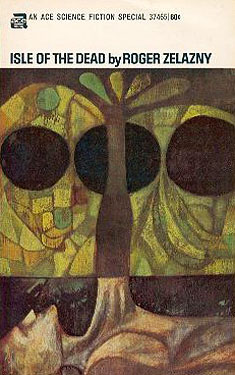Roger Zelazny
Completed 12/9/2015, Reviewed 1/4/2016
4 stars
There is a painting by Swiss artist Arnold Bocklin called
“Isle of the Dead”. It shows a boat being
rowed to an island that looks like the remains of a caldera. Zelazny used the image as inspiration for the
setting of the ending of his book by the same name. But
the setting is only a small part of this book.
What’s really amazing is that Zelazny creates a mythology from scratch
and his main character is one of the gods, albeit a reluctant one. It’s the primary reason I found this book so
intriguing.
 Zelazny has written many books that are based in a religion
or mythology. His two Hugo award winning
novels were plays on Greek mythology and the Hindu pantheon. So it only seems natural that he would have
eventually created one himself. The
religion is that of an alien race, the Pei’ans.
The premise is that when someone terraforms a planet, or worldscapes, they
go through a ritual that basically binds them to one of the gods of the Pei’an
pantheon, becoming a sort of avatar for the god. Francis Sandow is the oldest living human,
having been sent on an early interstellar mission, where because of relativity,
he’s survived many centuries. New
technology also keeps him youthful and healthy.
Since he made some wise investments before his mission, he’s also one of
the richest people in the world. Because
of his wealth, he’s able to become an apprentice to a worldscaping master,
creates a world, and becomes the avatar for Shimbo, god of Thunder.
Zelazny has written many books that are based in a religion
or mythology. His two Hugo award winning
novels were plays on Greek mythology and the Hindu pantheon. So it only seems natural that he would have
eventually created one himself. The
religion is that of an alien race, the Pei’ans.
The premise is that when someone terraforms a planet, or worldscapes, they
go through a ritual that basically binds them to one of the gods of the Pei’an
pantheon, becoming a sort of avatar for the god. Francis Sandow is the oldest living human,
having been sent on an early interstellar mission, where because of relativity,
he’s survived many centuries. New
technology also keeps him youthful and healthy.
Since he made some wise investments before his mission, he’s also one of
the richest people in the world. Because
of his wealth, he’s able to become an apprentice to a worldscaping master,
creates a world, and becomes the avatar for Shimbo, god of Thunder.
The book begins with Sandow discovering that someone has
kidnapped several of his old friends and lovers. He begins a quest to find them, only to find
out that it has to do with jealousy of him being an Earthling who has attained
godhood. All the other gods are
Pei’an. The final showdown takes him to
the “Isle of the Dead”, a remote location on one of the planets he
worldscaped.
The reason I really liked this book is because of the
religion, and Sandow’s hesitancy in fully embracing his status as a god. In fact, he’s an agnostic, even though
strange things happen like statues of Shimbo glowing when visits a temple. While there isn’t anything messianic about
him, it does have overtones of the reluctant messiah theme.
Another part that was fascinating was his visits to the
worlds he created. Besides terraforming,
he also created all the animals on the planets.
On each planet, we get to meet some of the animals briefly. They add an occasional touch of humor to the
epic scale of Sandow’s and ultimately Zelazny’s world building.
The plot is short and almost secondary to the world that
Zelazny created. It’s good, and the end
is action packed, but the real draw for this book is the mythology. Besides being nominated for a Nebula award, I
think this book could have won a Mythopoeic award if it had existed at the time
of publication. I give this book four
out of five stars.
No comments:
Post a Comment